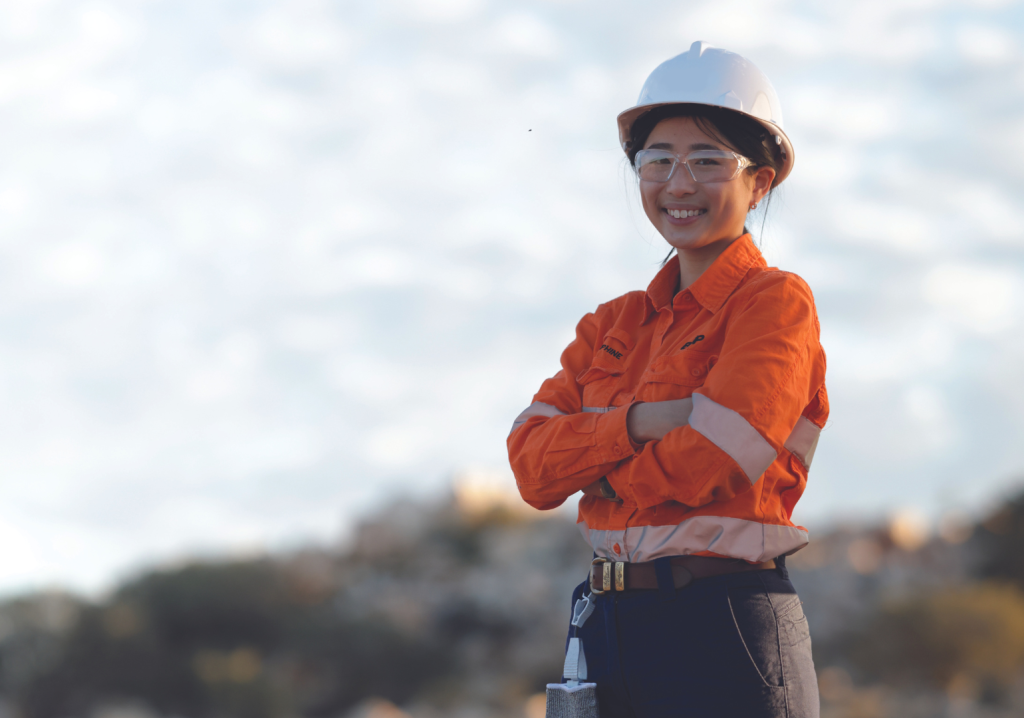For this trio of emerging mining engineers, the industry is more than just moving rocks around – it’s a rewarding endeavour with a focus on sustainability.
“I’m always thinking on my feet”
“My fascination with commodities traces back to my family’s heritage,” Josephine Liantono of BHP told create. “My grandfather owned businesses including a jewellery shop in Indonesia. During primary school, he gave me the daily responsibility to report to him the price of the US dollar, gold and oil prices. He would then challenge me to forecast the next day’s price movements.
“As Senior Engineer – Ventilation and Mine Services, I love the challenge of underground mining – its dynamic nature means I’m always thinking on my feet. I believe there is something inherently captivating and charming about the underground mining environment, which always brings me so much joy every time I’m down there.

“Whether we’re facing technical obstacles, grappling with logistical hurdles or celebrating our successes, there’s an unspoken bond that unites us – a shared sense of purpose and a collective determination to overcome any obstacle that comes our way.
“What excites me about the future of mining engineering is its potential to be a driving force for positive change: embracing sustainability principles and leveraging innovation. As the world pivots towards renewable energy, the demand for metals and minerals surges. In response, the mining industry has the opportunity to reduce its environmental footprint and contribute to the development of a cleaner, more sustainable future for generations to come.”
“Automation has enhanced optimisation”
“I’m currently completing my Master of Professional Engineering at the University of Western Australia,” Jacob Winter-Bock said. “What I find most compelling about mining engineering is the integration of practical and theoretical knowledge. The universal applicability of the skills I am developing speaks to a global demand for mining engineers, underscoring the profession’s relevance and my place within the international community.
“An oversimplification that gets thrown around in the industry is that a mining engineer moves rocks from A to B. But each project presents a unique set of variables, from geological diversity to financial constraints, requiring innovative solutions that are anything but straightforward. Navigating these challenges has been both daunting and immensely rewarding.

“Sustainable innovation like green hydrogen production and electrification means that the mining industry is poised to revolutionise not only its operational standards but also its environmental impact. The shift towards automation and sustainable practices not only enhances safety and public perception but also holds the potential to redefine mining’s contribution to society at large. Being part of an industry that has the means and the motive to innovate is rare.
“In recent years, automation has significantly enhanced optimisation capabilities, enabling us to harness and predict accurate real-time data. This integration helps to better predict and meet production targets, responding to the growing demand for minerals. Moreover, the ability to operate machinery remotely increases safety by reducing human exposure, which is particularly beneficial as we mine at greater depths.”
“We have to consider environmental factors”
“I’m a third-generation miner, and work as a chemical engineer and plant metallurgist for Fortescue at Iron Bridge in north Western Australia,” Zac Chrzanowski said. “At first, I had some reservations about working FIFO, but now I love it. I work eight days on, and six days off, giving me much more freedom to go on little holidays without having to take additional leave.
“The primary responsibility of my job is ensuring that the concentration of the refined product is produced to the buyer’s exact specifications. This kind of problem-solving is one of my favourite parts of the job. There’s also lots of hands-on work, and I’ve had my fair share of hosing down bunds and spinning bolts.
“The optimisation and sustainability side of my work is really interesting too. It’s not only about making the perfect metal – we also have an emphasis on doing it by using fewer resources such as water and electricity. We also have to consider other environmental factors such as effectively discharging our tailings or reducing their effect on the environment.
“I enjoy collaborating with other kinds of engineers. On any day, there’s about 800 people on site, and over the course of a swing I will probably speak to upwards of 200 of them. I love working on that bridge between hearing an idea and making it happen.”
There are countless engineers leading change in the world. Nominations for the Engineers Australia Excellence Awards are now open.
